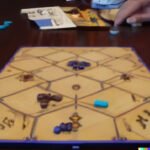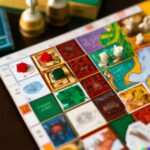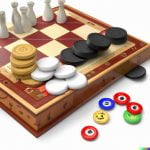Children’s classic board games are a timeless source of entertainment and learning for kids of all ages. From traditional games like Monopoly and Candy Land to modern adaptations, these classic board games have been an integral part of childhood for generations. In this article, we will take a trip down memory lane and explore the enduring appeal and benefits of children’s classic board games.
Playing children classic board games is not just about having fun; it also offers numerous developmental benefits for kids. These timeless games help children develop essential skills such as critical thinking, decision-making, problem-solving, and social interaction. With the rise of digital technology, classic board games continue to remain relevant in providing a screen-free alternative for kids to engage in meaningful play.
In the following sections, we will delve into the various aspects of children’s classic board games, including their impact on child development, top must-have games, tips for teaching kids how to play, and the future of classic board games in the digital age.
Whether you’re a parent looking to introduce your child to these beloved games or a nostalgic adult looking to rediscover the joy of playing them, this article aims to provide valuable insights into the world of children’s classic board games.
The Benefits of Playing Classic Board Games for Children’s Development
Playing classic board games can have a significant impact on a child’s development. These timeless games offer numerous benefits that go beyond just entertainment. One of the key advantages is the opportunity for children to learn important social and cognitive skills while having fun.
First and foremost, classic board games encourage critical thinking and problem-solving. Whether it’s planning the best move in chess or strategically buying properties in Monopoly, children are constantly using their brains to make decisions and solve challenges. This helps improve their cognitive abilities and prepares them for tackling real-life problems in the future.
Moreover, classic board games also promote social interaction among children. In today’s digital age, it’s easy for kids to get absorbed in their individual devices, leading to a decline in face-to-face communication. By playing board games together, children learn valuable skills such as taking turns, following rules, and good sportsmanship. These interactions are essential for their social development and help them build strong interpersonal relationships.
Lastly, classic board games can enhance a child’s language and literacy skills. Many of these games involve reading instructions, discussing strategies with other players, and interpreting various game elements. As a result, children can improve their vocabulary, comprehension, and communication abilities without even realizing it.
| Benefits of Classic Board Games | Impact on Children’s Development |
|---|---|
| Promote critical thinking and problem-solving | Improves cognitive abilities |
| Encourage social interaction | Develops essential social skills |
| Enhance language and literacy skills | Improves vocabulary and comprehension |
Top 10 Must-Have Children Classic Board Games
When it comes to children classic board games, there are some timeless favorites that have been enjoyed by generations. These top 10 must-have classic board games offer endless hours of fun and entertainment for children of all ages.
Monopoly
Monopoly is a classic board game that teaches children about money management, negotiation, and strategy. It also encourages social interaction as players buy, sell, and trade properties to become the wealthiest player.
Candy Land
Candy Land is a colorful and whimsical game that is perfect for young children. This sweet-themed board game helps children learn colors, counting, and turn-taking while they journey through the magical world of Candy Land.
Chutes and Ladders
Chutes and Ladders is a simple yet engaging game that teaches children about counting and decision-making. The game also reinforces the concept of consequences as players climb ladders or slide down chutes based on their spin.
These are just a few examples of the top 10 must-have classic board games for children. Whether it’s teaching valuable life skills or simply providing pure entertainment, these timeless games continue to be beloved by kids around the world.
How to Choose the Best Classic Board Game for Your Child’s Age and Skill Level
When it comes to choosing the best classic board game for your child, it’s important to consider their age and skill level. Not all board games are suitable for every child, so selecting the right game can enhance their playing experience and ensure they have fun while also learning. Here are some tips on how to choose the best classic board game for your child:
- Consider their age: Take into account your child’s age when choosing a classic board game. Younger children may not have the attention span or understanding of complex rules, so opt for games that are designed for their age group.
- Assess their skill level: Some classic board games require certain skills such as critical thinking, strategy, or dexterity. Consider your child’s abilities and choose a game that will challenge them without being too overwhelming.
- Read reviews and recommendations: Before making a purchase, take some time to read reviews and recommendations from other parents or experts. This can give you insight into whether a particular classic board game is suitable for your child.
It’s also important to consider your child’s interests and preferences when choosing a classic board game. Whether they enjoy puzzles, word games, or strategic challenges, there are numerous options available that cater to different interests and inclinations. By considering all these factors, you can ensure that you select a classic board game that will be enjoyable and beneficial for your child.
The Evolution of Classic Board Games
Classic board games have been a staple in children’s playtime for generations, providing endless hours of fun and entertainment. These timeless games have evolved over the years, from their traditional forms to modern adaptations that cater to the changing needs and interests of today’s children.
The evolution of classic board games has brought about new versions and variations that appeal to a wider audience, including younger children who may be more attracted to colorful and interactive game boards. Some classic board games have even been transformed into digital formats, making them accessible on various devices such as tablets and smartphones.
Below are some examples of how classic board games have evolved from their traditional forms to modern adaptations:
- Traditional: Monopoly
- Modern Adaptation: Monopoly Empire where players buy famous brands instead of properties
- Traditional: Scrabble
- Modern Adaptation: Scrabble Junior with game boards designed for younger kids featuring pictures and words
- Traditional: Sorry.
- Modern Adaptation: Sorry. Sliders with a twist on the original game using sliding pieces
As classic board games continue to adapt to the digital age, they are able to reach a broader audience and remain relevant in today’s fast-paced world while still preserving the nostalgia and charm that make them timeless favorites for families.
Whether in their traditional or modern forms, these beloved children classic board games continue to hold a special place in every child’s heart as they provide opportunities for learning, social interaction, and pure enjoyment.
The Role of Classic Board Games in Family Bonding and Quality Time
Classic board games have always played a significant role in bringing families together, fostering quality time and creating lasting memories. These games have stood the test of time and continue to be a staple in many households, providing an avenue for people of all ages to come together and engage in friendly competition. Whether it’s a classic game of Monopoly, Scrabble, or Candy Land, these timeless favorites bring joy and laughter to family game nights.
One of the key benefits of classic board games is the opportunity for families to connect and bond with one another. With today’s fast-paced lifestyle and the prevalence of technology, it can be challenging to find activities that allow for genuine interaction.
Classic board games offer a screen-free alternative that encourages face-to-face communication and fosters stronger relationships among family members. Through friendly competition and cooperative play, classic board games create an atmosphere of fun and camaraderie that strengthens family ties.
Moreover, classic board games provide an opportunity for parents to instill important values such as sportsmanship, teamwork, and critical thinking in their children. As kids engage in gameplay, they learn to follow rules, take turns, strategize, problem-solve, and accept defeat gracefully. These valuable life skills are essential for children’s personal growth and development. By participating in classic board games with their children, parents can actively participate in their educational experience while simultaneously enjoying quality bonding time with them.
Tips and Tricks for Teaching Children How to Play Classic Board Games
When it comes to teaching children how to play classic board games, there are a few tips and tricks that can help make the experience enjoyable and educational for both the child and the adult. Whether it’s introducing a new game or helping them master the rules of an old favorite, these strategies can make game time a fun and positive experience.
Start With Simple Games
If your child is new to classic board games, it’s best to start with simple games that have easy-to-understand rules. Games like Candy Land, Chutes and Ladders, or Memory are great choices for younger children who are just getting started with board games. Starting with simpler games helps children develop basic gaming skills such as taking turns, following rules, and understanding game mechanics.
Use Visual Aids
For children who are visual learners, using visual aids can be extremely helpful in teaching them how to play classic board games. This can include using colorful markers or tokens to represent game pieces, creating visual guides to help them understand the rules, or even using videos or online tutorials to demonstrate how the game is played.
Patience and Encouragement
Teaching children how to play classic board games requires patience and encouragement. It’s important for adults to remain patient as children learn the rules and strategies of each game. Encouraging their efforts and praising their successes will help build their confidence and make the overall gaming experience more enjoyable for everyone involved.
By using these tips and tricks, adults can help children develop a love for classic board games while also honing important skills like critical thinking, decision making, and social interaction. And most importantly, they can create lasting memories that will stay with children long after they’ve outgrown their favorite childhood classics.
The Future of Classic Board Games
As the world continues to embrace digital advancements, classic board games are also evolving to adapt to the digital age. This adaptation has brought about a new way for children to engage with these timeless games, combining the traditional aspects of board games with modern technology. From online versions of classic board games to interactive app adaptations, the future of classic board games is heading towards a more digital landscape.
One of the main benefits of adapting classic board games to the digital age is accessibility. With online versions and apps, children can easily access their favorite classic board games from virtually anywhere, whether it’s on their tablets, smartphones, or computers. This allows for more opportunities for children to play and learn from these classic games.
Moreover, the digital adaptation of classic board games often includes interactive elements that make the gaming experience more engaging and entertaining for children. Whether it’s animated characters, sound effects, or interactive challenges, these digital adaptations add a new layer of excitement to the classic board game experience.
The integration of technology into classic board games also opens up possibilities for global connectivity and multiplayer interactions. Children can now play classic board games with friends and family members who may be located in different parts of the world through online platforms. This not only promotes social interactions but also enhances the overall gaming experience for children.
| Benefits | Details |
|---|---|
| Accessibility | Online versions and apps allow easy access from anywhere |
| Engagement | Digital adaptations add interactive elements for more engaging experience |
| Global Connectivity | Multiplayer interactions with friends and family from different locations |
Conclusion
In conclusion, children classic board games have stood the test of time and will continue to hold a special place in every child’s heart for numerous reasons. These games not only provide entertainment and fun but also offer valuable benefits for a child’s development. From promoting cognitive skills to teaching important life lessons such as sportsmanship and strategizing, classic board games play a crucial role in shaping a child’s growth and overall character.
Additionally, these timeless games act as a bridge that connects generations, providing an opportunity for parents and grandparents to bond with their children or grandchildren while reliving their own childhood memories. The simplicity and nostalgia of classic board games create a unique atmosphere that fosters quality time and meaningful interactions among family members.
Furthermore, the enduring appeal of children classic board games lies in their adaptability to the digital age. While modern adaptations may offer new features and technology, the essence of these traditional games remains unchanged.
The charm of rolling dice, moving game pieces, or drawing cards cannot be replicated on a screen. As such, it is safe to say that classic board games will continue to hold a cherished place in every child’s heart for years to come, serving as an enduring source of joy and enrichment for generations to come.
Frequently Asked Questions
What Are the Most Popular Classic Board Games?
The most popular classic board games include Monopoly, Scrabble, Chess, Checkers, and Clue. These games have stood the test of time and continue to be beloved by people of all ages.
What Board Games Can a 5 Year Old Play?
Some board games that are suitable for 5-year-olds include Candy Land, Chutes and Ladders, Hi Ho! Cherry-O, and Uno Moo. These games are simple to understand and are designed with younger children in mind.
What Are Old Fashioned Children’s Indoor Games?
Old fashioned children’s indoor games include Hide and Seek, Simon Says, Musical Chairs, Red Light Green Light, and Duck Duck Goose. These timeless games require little to no equipment and encourage active play among children.

I love playing all kinds of games – from classics like Monopoly to modern favourites like Ticket to Ride.
I created this blog as a way to share my love of board games with others, and provide information on the latest releases and news in the industry.





